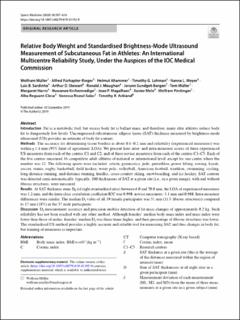Relative Body Weight and Standardised Brightness-Mode Ultrasound Measurement of Subcutaneous Fat in Athletes: An International Multicentre Reliability Study, Under the Auspices of the IOC Medical Commission
Müller, Wolfram; Fürhapter-Rieger, Alfred; Ahammer, Helmut; Lohman, Timothy G.; Meyer, Nanna L.; Sardinha, Luís B.; Stewart, Arthur D.; Maughan, Ronald J.; Sundgot-Borgen, Jorunn; Müller, Tom; Harris, Margaret; Kirihennedige, Nuwanee; Magalhães, João P.; Melo, Xavier; Pirstinger, Wolfram; Reguant-Closa, Alba; Risoul-Salas, Vanessa; Ackland, Timothy R.
Peer reviewed, Journal article
Published version
Permanent lenke
https://hdl.handle.net/11250/2654210Utgivelsesdato
2019Metadata
Vis full innførselSamlinger
- Artikler / Articles [2119]
- Publikasjoner fra Cristin [1107]
Sammendrag
Introduction: Fat is a metabolic fuel, but excess body fat is ballast mass, and therefore, many elite athletes reduce body fat to dangerously low levels. Uncompressed subcutaneous adipose tissue (SAT) thickness measured by brightness-mode ultrasound (US) provides an estimate of body fat content. Methods: The accuracy for determining tissue borders is about 0.1–0.2 mm and reliability (experienced measurers) was within ± 1.4 mm (95% limit of agreement, LOA). We present here inter- and intra-measurer scores of three experienced US measurers from each of the centres C1 and C2, and of three novice measurers from each of the centres C3–C5. Each of the five centres measured 16 competitive adult athletes of national or international level, except for one centre where the number was 12. The following sports were included: artistic gymnastics, judo, pentathlon, power lifting, rowing, kayak, soccer, tennis, rugby, basketball, field hockey, water polo, volleyball, American football, triathlon, swimming, cycling, long-distance running, mid-distance running, hurdles, cross-country skiing, snowboarding, and ice hockey. SAT contour was detected semi-automatically: typically, 100 thicknesses of SAT at a given site (i.e., in a given image), with and without fibrous structures, were measured. Results: At SAT thickness sums DI (of eight standardised sites) between 6.0 and 70.0 mm, the LOA of experienced measurers was 1.2 mm, and the intra-class correlation coefficient ICC was 0.998; novice measurers: 3.1 mm and 0.988. Intra-measurer differences were similar. The median DI value of all 39 female participants was 51 mm (11% fibrous structures) compared to 17 mm (18%) in the 37 male participants. Discussion: DI measurement accuracy and precision enables detection of fat mass changes of approximately 0.2 kg. Such reliability has not been reached with any other method. Although females’ median body mass index and mass index were lower than those of males, females’ median DI was three times higher, and their percentage of fibrous structures was lower. The standardised US method provides a highly accurate and reliable tool for measuring SAT and thus changes in body fat, but training of measurers is important.
Beskrivelse
This article is distributed under the terms of the Creative Commons Attribution 4.0 International License (http://creativecommons.org/licenses/by/4.0/), which permits unrestricted use, distribution, and reproduction in any medium, provided you give appropriate credit to the original author(s) and the source, provide a link to the Creative Commons license, and indicate if changes were made.
